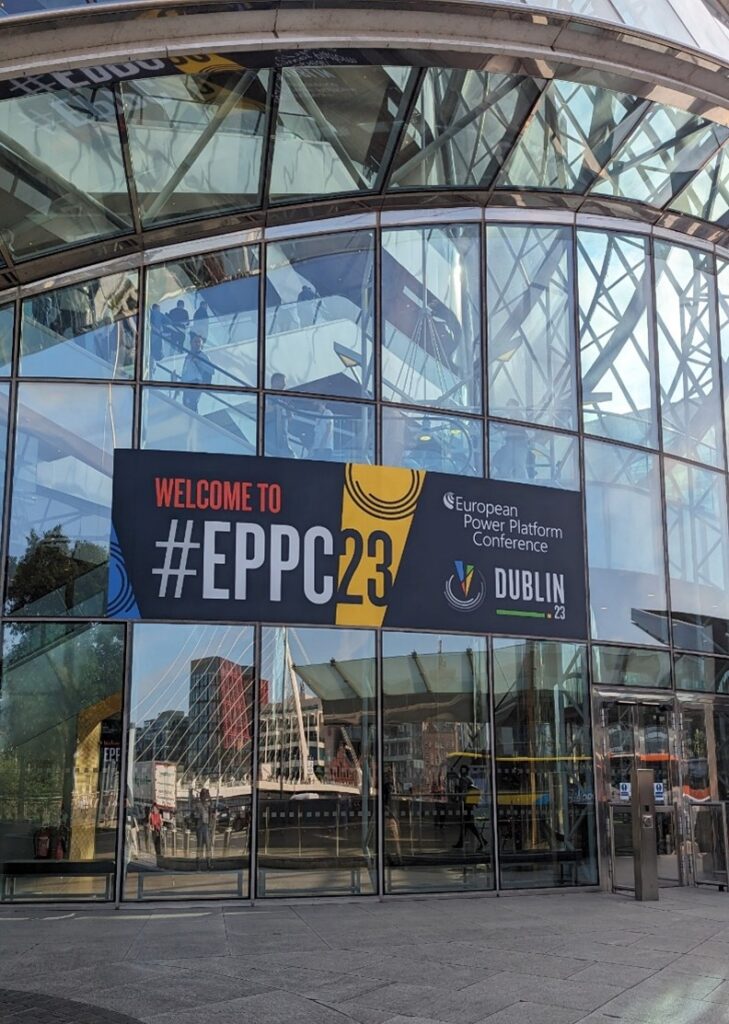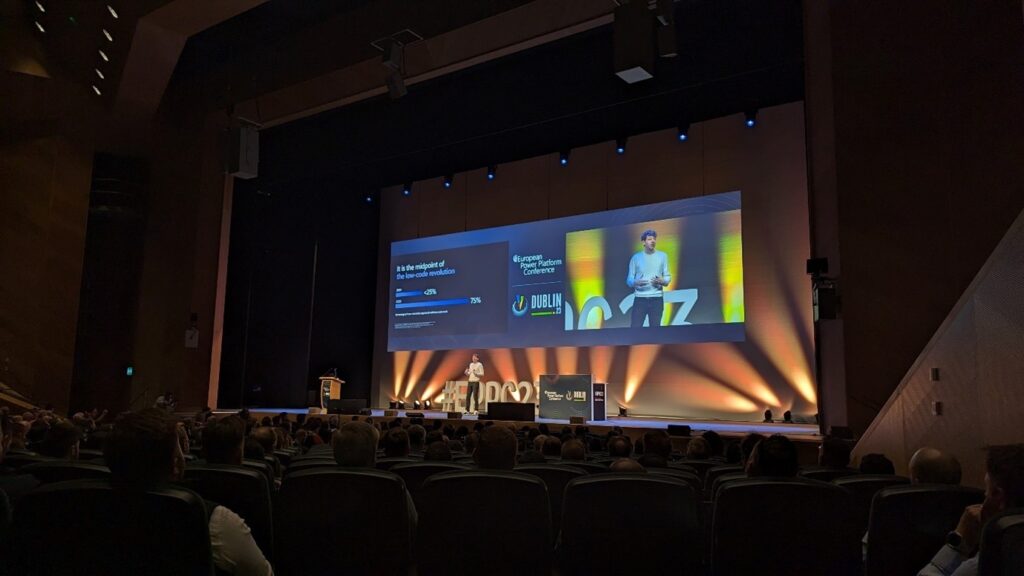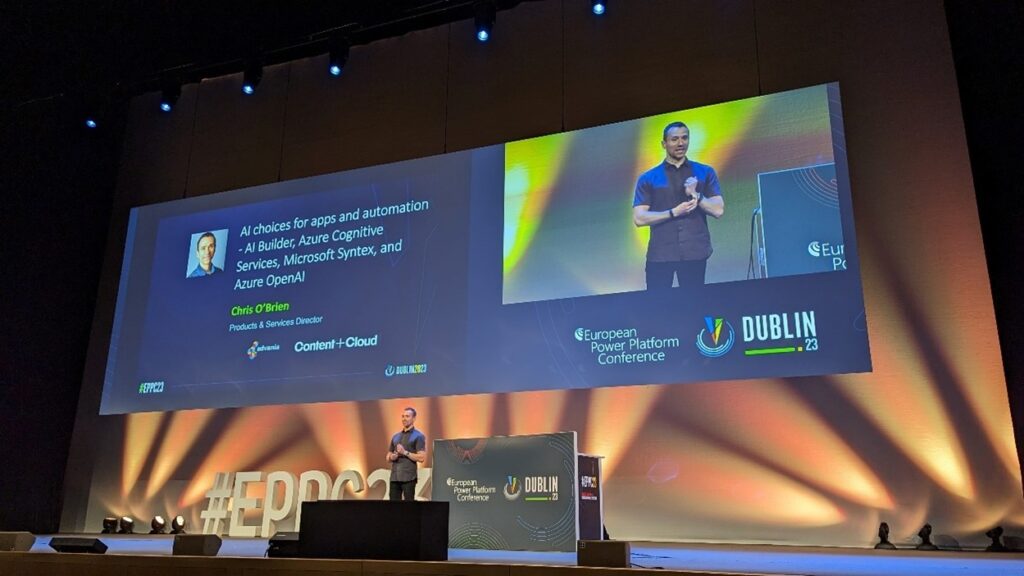
More and more organisations are looking to empower their people to create with no-code solutions. The Power Platform community has been in Dublin to share the latest announcements and best practices at the second annual European Power Platform Conference. We sent two of our Power Platform experts, Natasza Kosakowska and Steve Worrell from our Solutions Architecture team, to soak up the news and what the new developments mean for our clients.
What is the European Power Platform Conference?
The second ever edition of the European Power Platform Conference took place from 20th to 22nd June, with Dublin providing a wonderful backdrop as the host city.

The second European Power Platform Conference took place in Dublin, Ireland. Credit: Natasza Kosakowska.
We were privileged to attend on behalf of Content+Cloud and, as bona fide Power Platform geeks, we were also super excited to see what was in store.
For starters, over 1,250 other like-minded Power Platform enthusiasts were present, highlighting the exponential growth in popularity and uptake of this technology, increasing significantly on the 2022 conference attendee total.
There was also a genuine mix of job roles in attendance from consultants, developers, architects to sales and recruiters, as well as members of the Microsoft product team and Most Valuable Professionals (MVPs), again emphasising the growing nature of the platform and its stakeholder base.
Keynote speech from Microsoft’s head of Power Platform
Charles Lamanna, Corporate VP, Business Apps and Platform at Microsoft, also known as the head of Power Platform at Microsoft, was the first days’ keynote speaker and captivated the audience with a rousing presentation on the topic of ‘Power Platform in the Age of AI – Copilot and More’.
Core to his presentation were the continued substantial growth of the Power Platform and how AI, through Copilot, will unlock the ability to build apps for even more users, broadening its audience. Microsoft’s aim is to make building apps as straightforward as utilising Microsoft Word.

Charles Lamanna, Corporate VP, Business Apps & Platform at Microsoft, presenting the keynote presentation. Credit: Natasza Kosakowska.
With regards to this current technological epoch of generative AI, integrated into business applications, Charles commented that “it is the most disruptive time I have witnessed” – and this is just the beginning.
Some of the other pertinent points made in the keynote revolved around Power Platform and Copilot.
Power Platform:
- Currently at 33 million monthly users
- Expected to be the platform for 75% of enterprise apps in existence by 2026
- 36,000 organisations already using AI-powered capabilities in Power Platform
Copilot:
- Will make Power Apps even more accessible, removing barriers to use
- Will accelerate innovation in organisations.
- Expected to be available in Europe from autumn 2023
- In Power Automate flows are 50% faster to build and 70% less errors occur on first run
Charles also revealed that a new user interface for Power Automate is imminent – this will improve flow action usability and visibility through a larger canvas on which flow steps will sit.
Sessions and takeaways at the European Power Platform Conference
There were more than 100 sessions dedicated to Power Platform topics, ranging from business user orientated talks and workshops, through others focused on governance and best practices, to sessions aimed at professional developers. We attended over 30 of these to get as much exposure to different perspectives and topics as possible that we can bring back to our clients.
Here are some of the sessions we found particularly insightful:
AI choices for apps and automation in 2023 – understanding AI Builder, Azure Cognitive Services, Microsoft Syntex, and Azure OpenAI
Our very own Chris O’Brien, Content+Cloud Products and Services Director and Microsoft MVP, delivered a session on artificial intelligence (AI) within Microsoft’s offering, and provided key considerations for choosing one technology over another, depending on your specific needs.
Whether it’s Microsoft Syntex, AI Builder, Azure Cognitive Services or Power Virtual Agents, Chris had a demo for all of them. He described scenarios where using one of the mentioned technologies should be preferred, and what things you should look out for.

Content+Cloud’s own Chris O’Brien presenting on AI choices for apps and automation. Credit: Natasza Kosakowska.
Copilot AI in Power Platform
This exciting session previewedg the capabilities of Copilot in Power Automate and Power Apps and how it utilises responsible AI principles with customer data.
In short, Copilot allows users to build apps with natural language by submitting written descriptions of requirements,ensuring the app is automatically built for end users. We saw demos of Copilots in action for Power Automate and Power Apps.
In Power Automate, a flow was auto-generated by Copilot simply from a user input of ‘Send an automated email to XX’. The requestor was then free to edit the flow that had been created in seconds.
Additionally, Copilot was asked ‘What does this flow do?’ when pointed at a separate more complex flow. In a few seconds, it assessed and produced a clear description in natural language of each of the steps of the flow and what the outputs were. This also applies and works for Canvas Apps (‘What does this app do?’). This feature alone will prove extremely useful for any admins/makers who may inherit existing complex apps and need to interrogate and understand them quickly.
In the Power Apps example, a Canvas App was automatically created based on an unformatted Excel spreadsheet (not normally possible), with Copilot taking care of the formatting to ensure the app built correctly with no errors.
Dataverse Security Secrets Revealed
This session was delivered by Chris Huntingford, focusing on security tips and tricks in Dataverse. Comparing Dataverse security to a waterfall, Chris made it easier to understand how Teams compares to Business Units, and when should we use which concept to provide access to Dataverse tables.
Highlighting that there are only three security roles that give users access to the environment picker within make.powerapps.com, he suggested that instead of directing users directly to the maker experience, building a custom environment picker should be considered instead to better control which environments are being accessed by users. While this is not an issue for most organisations, some provide users with access to tens or hundreds of environments at a time, which can prove to be quite a frustrating experience.
Power BI and Power Automate and what they do best
Delivered by the brilliant Laura Graham-Brown, the session was based on a real-life scenario of retrieving data from a third-party app.
She explained making necessary data transformations through the use of Power Automate, refreshing the Power BI dataset triggered by creation of a new transformed data file, extracting data from a dataset and utilising a cloud flow to send an automated summary of the data using a Power BI visual code.
With Laura, you learn something new every time.
Designing your Power Platform environment strategy
This highly insightful session from Aaron Rendell and Ben Haynes called out the key considerations when creating an environment management strategy.
Some of the recommendations highlighted were:
- Restrict new production environment creation to admins.
- Limit the creation of solutions within the default environment and promote use of provisioned environments instead
- Follow a standardised set of environment types such as Default, Personal Productivity, Departmental and Custom, and create DEV, Test and Production environments where ALM is required.
- Implement ALM (Dev, Test, Production) via solutions and establish a change management process
- Safeguard data by using the DLP tools available in Power Platform Admin Center and monitor, review and update on a regular basis where new risks appear.
Diversity and inclusion lunch
Natasza was one of a limited number of attendees (150) lucky enough to attend the diversity and inclusion (D&I) lunch hosted by April Dunnam, a huge contributor and well-known face in the Power Platform community and now a deserved employee of Microsoft.
Multiple Power Platform community members (including David Warner, MVP and Senior Program Manager at Microsoft) sat on the Q&A panel and dedicated time for open questions from the audience.
April herself answered Natasza’s question about how to get started as a community contributor and encouraged Natasza to post online her own learnings and insights from implementing Power Platform solutions.

April Dunnam, speaking at the D&I lunch. Credit: Natasza Kosakowska.
Networking with the Power Platform Community
One of the great benefits of attending a conference is the social side, having the opportunity to mingle and network with so many talented technologists in one place. Discussing successes and lessons learnt with Power Apps admins, developers and makers in other organisations, and hearing how they work with the Power Platform in general, is incredibly useful and rewarding.
We were fortunate enough to chat to several Microsoft MVPs, allowing us to pick their brain and ask them questions (‘Can we have a selfie?’). Hearing these MVPs expand on their journey and show their passion for learning and spreading knowledge to the wider community was an inspiring experience.

Natasza and Microsoft MVP Scott Durow, Father of the Ribbon Workbench, an amazingly useful tool when building model-driven apps or in Dynamics 365. Credit: Steve Worell.
Another fantastic corollary of attending EPPC2023 was meeting and getting to know an Advania Finland colleague, Markus Rautio, Production Manager and Product Owner of low-code solutions. We’re looking forward to collaborating with Markus and his team going forward.
In summary, it was a great privilege and a wonderfully valuable experience attending the European Power Platform Conference. The learnings we’ve taken from the sessions on offer not only expand our knowledge and skillset but can be rapidly implemented on projects with our current and future customers, bringing further cutting-edge innovation to the Power Apps services we provide.
Power Platform is going from strength to strength with its huge uptake by organisations globally. We’d expect to see that popularity mirrored in the growth of this conference annually going forward.
Here’s to EPPC 2024 and the continued success of the Power Platform.


